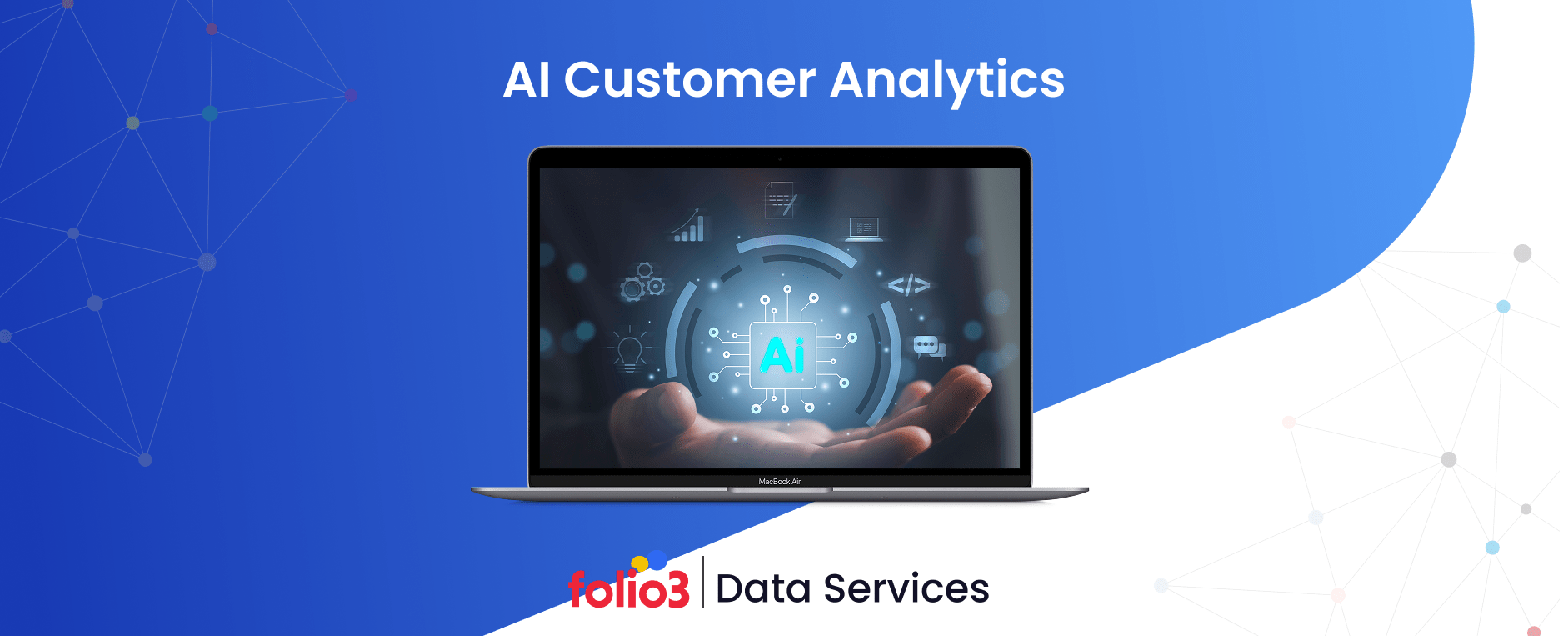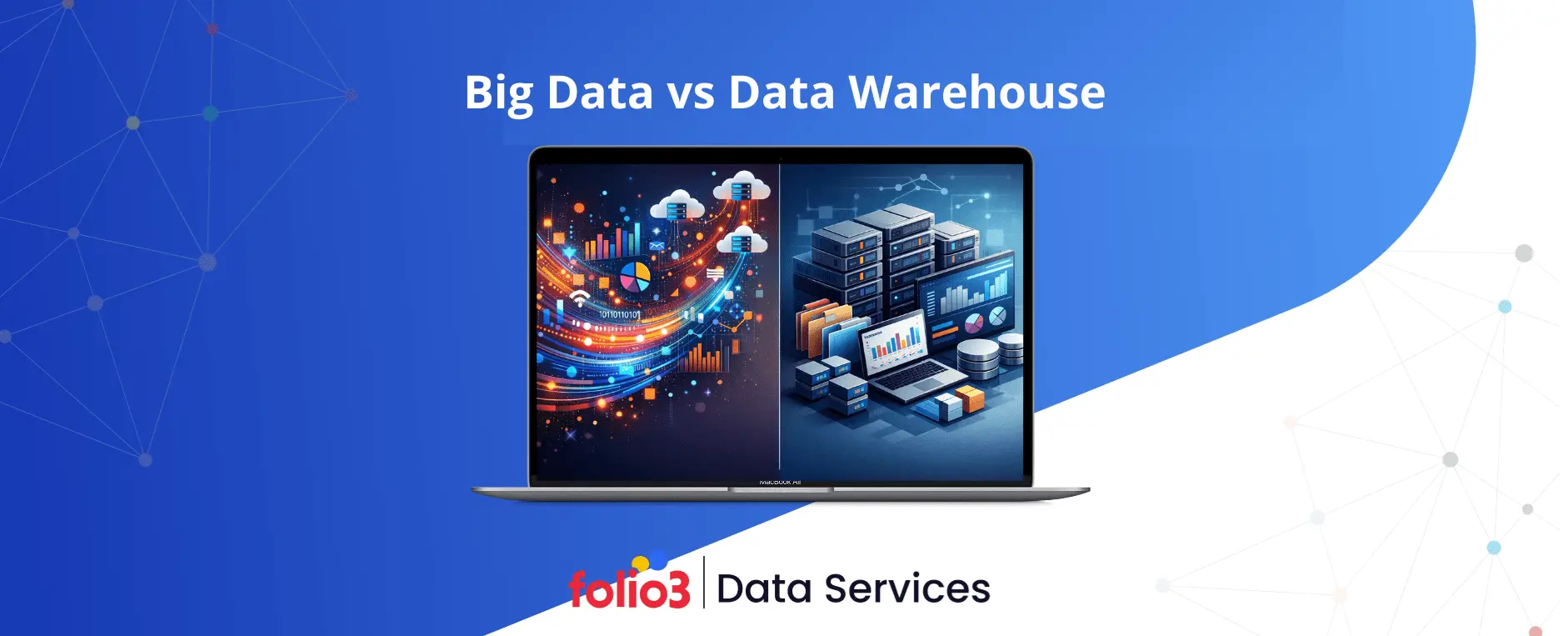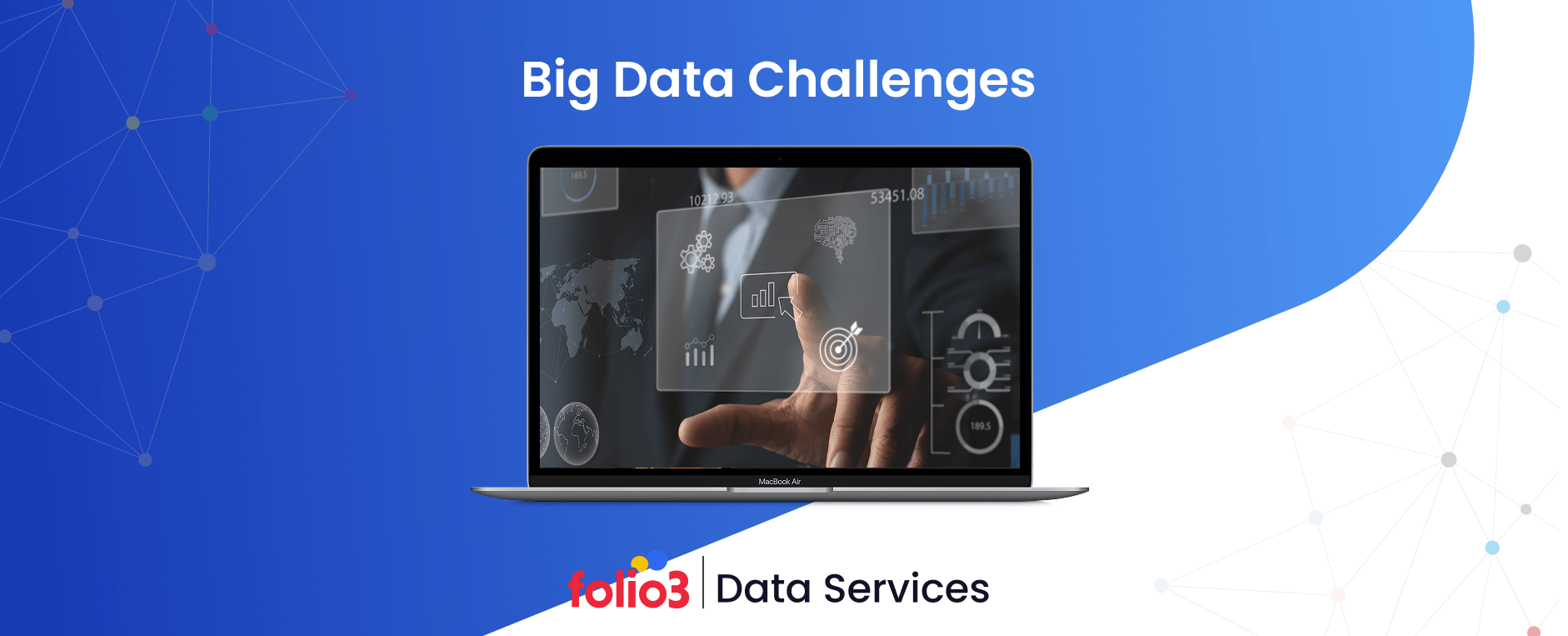Customer expectations have evolved. Now, consumers demand personalized experiences, real-time responses, and proactive support that anticipates their needs. Traditional analytics, built on historical data and manual reporting, can’t keep up with the speed or complexity of these interactions.
AI customer analytics marks a shift from reactive to predictive insights. By analyzing millions of interactions in real time, businesses can detect emerging trends and act instantly to enhance the customer journey.
But this shift is more than just technological, it’s strategic. According to studies, companies using AI-driven customer analytics see up to a 50% reduction in resolution times and 42% higher customer satisfaction, highlighting the real-world impact of smarter, faster decision-making.
What Makes AI Customer Analytics Different?
Customer analytics has evolved far beyond basic demographic segmentation and purchase history tracking. Modern AI customer analytics combines multiple data sources from support tickets and social media mentions to voice recordings and behavioral patterns into a unified intelligence platform.
The core difference lies in processing capability and predictive power. Traditional analytics tell you what happened. AI customer analytics tells you what’s likely to happen next and why it matters for your business. This predictive element transforms customer data from a historical record into a strategic asset for future planning.
AI customer analytics platforms can process unstructured data like customer emails, chat transcripts, and voice calls alongside structured data from CRM systems and transaction records. This comprehensive view provides context that was previously impossible to achieve at scale.
How Does AI Transform Customer Service Analytics?
The transformation happens across three critical dimensions that fundamentally change how organizations approach customer intelligence. Here’s how:
1. Data Collection Gets Smarter
AI systems automatically capture and categorize customer interactions across every touchpoint. Phone calls get transcribed and analyzed for sentiment, chat conversations are parsed for intent, and social media mentions are monitored for brand perception shifts.
This level of real-time data collection eliminates the manual work that previously created delays and gaps in customer understanding. Support teams no longer need to tag tickets or categorize issues manually because AI systems identify patterns and classify interactions as they happen.
2. Analysis Becomes Predictive
Rather than simply reporting on past performance, AI customer analytics identifies leading indicators of customer behavior. Leveraging big data predictive analytics, the system might detect that customers who mention specific keywords in support conversations are more likely to churn within 30 days, enabling proactive retention efforts.
Machine learning algorithms continuously refine their predictions based on new data, becoming more accurate over time. This creates a feedback loop where customer insights become increasingly valuable as the system learns from more interactions.
3. Outcomes Drive Action
AI customer analytics platforms don’t just provide reports, they recommend specific actions based on data patterns. When the system identifies a customer at risk of churning, it might automatically trigger a retention campaign or alert the account manager to schedule a check-in call.
This shift from insight to action represents the most significant value of AI customer analytics. Data becomes operationally useful rather than just informative.
What Core Technologies Power AI Customer Analytics?
Understanding the underlying technologies helps enterprises make informed decisions about platform selection and implementation strategies.
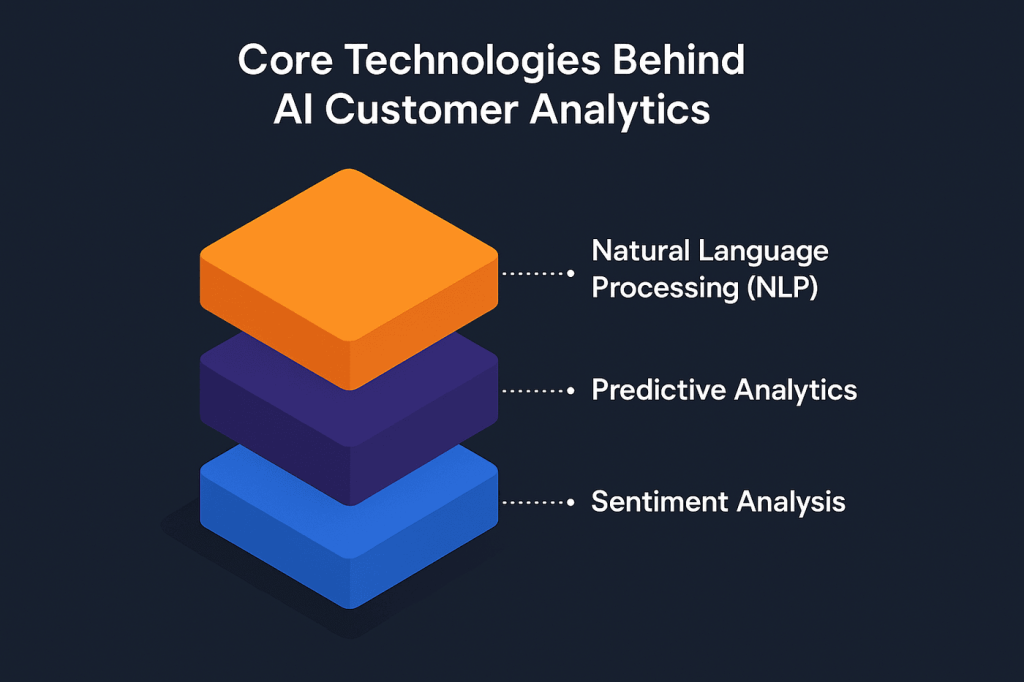
1. Natural Language Processing Opens New Data Sources
NLP technology enables AI systems to understand and analyze human language in customer communications, transforming unstructured text into structured insights.
Keyword Extraction Identifies Priority Issues
Advanced keyword extraction goes beyond simple word counting to identify concepts and themes in customer communications. The system might recognize that customers discussing “slow loading times” and “page timeouts” are describing the same underlying technical issue, even when using different terminology.
This capability is particularly valuable for identifying emerging issues before they become widespread problems. When multiple customers start mentioning similar concerns, the system can flag these patterns for immediate attention.
Rule-Based NLP Provides Consistent Classification
Rule-based NLP systems follow predefined logic to categorize customer communications. For example, any message containing words like “cancel,” “terminate,” or “end service” might automatically trigger churn prevention workflows.
These systems work well for structured scenarios where the business logic is clear and consistent. They provide reliable, predictable outcomes that support automated processes.
Machine Learning NLP Adapts to Context
Machine learning-based NLP systems learn from examples to understand context and nuance in customer communications. These systems can distinguish between a customer saying “this is sick” as slang for something impressive versus expressing genuine dissatisfaction.
The adaptive nature of these systems makes them effective for handling the complexity of human communication across different channels.
When powered by thoughtful generative AI implementation, NLP can continuously refine its understanding based on language trends and feedback loops, improving accuracy over time.
2. Predictive Analytics Anticipates Customer Needs
Predictive analytics uses historical data patterns to forecast future customer behavior, enabling proactive rather than reactive customer management strategies.
Organizations that leverage predictive analytics services can analyze dozens of variables simultaneously, from purchase history and support interactions to website behavior and demographic information, to identify customers most likely to upgrade, downgrade, or churn.
The accuracy of predictive models improves with data volume, making them particularly valuable for enterprises with large customer bases and extensive interaction histories.
3. Sentiment Analysis Measures Emotional Context
Sentiment analysis technology evaluates the emotional tone of customer communications, providing context that pure transaction data cannot capture.
As part of a broader data analytics strategy, modern sentiment tools go beyond simple positive/negative classifications to identify specific emotions like frustration, excitement, confusion, or satisfaction. This granular emotional intelligence helps customer service teams respond appropriately to different situations.
Real-time sentiment scoring also enables dynamic conversation routing, ensuring that highly frustrated customers reach experienced agents while routine inquiries can be handled through automated channels.
What Are the Top Business Applications of AI Customer Analytics?
Successful AI customer analytics implementations focus on specific use cases that deliver measurable business value rather than trying to solve every possible challenge simultaneously.
1. Optimizing Customer Experience
AI systems analyze customer journey data to identify friction points and optimization opportunities. By using customer experience analytics, businesses can track how users move through various touchpoints, predict where issues might occur, and take proactive steps to improve outcomes.
For example, if data shows that customers who spend more than three minutes on a particular website page are likely to abandon their purchase, the system might trigger a proactive chat offer or display helpful guidance content.
2. Monitoring Customer Sentiment in Real-Time
Continuous sentiment monitoring provides early warning systems for customer satisfaction issues. Rather than waiting for survey responses or complaint escalations, AI systems detect sentiment shifts in real-time across all communication channels.
This capability is particularly valuable during product launches, service changes, or crisis situations where customer sentiment can shift rapidly. Early detection enables quick response to prevent minor issues from becoming major problems.
3. Identifying and Categorizing Customer Issues Automatically
AI systems automatically categorize and prioritize customer issues based on content analysis and historical patterns. This automation reduces response times and ensures that serious problems receive immediate attention.
This automation reduces response times and ensures that serious problems receive immediate attention. As part of broader efforts in data analytics and digital transformation, these AI-driven categorizations help organizations modernize customer support processes and make data-backed service improvements.
Over time, the system becomes more sophisticated by learning from resolution outcomes and customer feedback, leading to increasingly accurate priority assignments.
4. Analyzing Customer Feedback at Enterprise Scale
Manual analysis of customer feedback becomes impossible at enterprise scale, but AI systems can process thousands of feedback submissions simultaneously while maintaining consistent analysis quality.
These systems identify themes and trends across large volumes of feedback, highlighting areas where customer experiences consistently fall short of expectations or exceed them.
For organizations managing massive data volumes, partnering with a data lake consulting provider can support scalable storage and unified access to customer feedback across channels.
5. Automating Response Suggestions for Support Teams
AI systems analyze incoming customer inquiries and suggest relevant responses based on successful resolution patterns from similar situations. By pairing these models with AI data extraction solutions, support platforms can quickly pull key details from emails, chat logs, and attached documents, giving agents the context they need to reply accurately. This capability accelerates response times while maintaining quality consistency across different agents.
The suggestions improve over time as the system learns from successful and unsuccessful interaction outcomes, creating a continuously improving knowledge base.
6. Predicting Future Customer Behavior Patterns
Behavioral prediction models identify customers likely to take specific actions, upgrading services, requesting cancellations, or making additional purchases, enabling targeted interventions.
These predictions become actionable through automated workflows that trigger appropriate responses based on predicted likelihood and business priorities.
7. Analyzing Historical Patterns for Strategic Planning
AI systems identify long-term trends and patterns in customer behavior that inform strategic business decisions. These insights might reveal seasonal patterns, demographic shifts, or changing preferences that impact product development and marketing strategies.
Staying updated with data analytics trends helps organizations refine their forecasting methods and apply the most relevant techniques to improve resource planning across customer-facing functions.
8. Creating AI-Driven Customer Survey Strategies
AI systems optimize survey timing, content, and delivery methods based on individual customer preferences and response patterns. This personalization increases response rates and improves data quality. By pairing these surveys with AI enterprise search solutions, businesses can instantly surface related feedback, historical insights, and customer interaction data, ensuring that follow-up actions are well-informed and contextually relevant.
Dynamic survey content adjusts questions based on previous responses and known customer characteristics, creating more relevant and engaging feedback experiences.
9. Implementing Predictive Churn Prevention
Churn prediction models identify customers at risk of cancellation weeks or months before they take action, enabling proactive retention efforts when they’re most likely to succeed.
These models use advanced predictive analytics techniques to analyze usage patterns, support interactions, payment behavior, and engagement metrics, resulting in more accurate and timely risk assessments.
10. Measuring Customer Satisfaction Automatically
AI systems continuously monitor customer satisfaction indicators across all interaction channels, providing real-time CSAT scores without requiring explicit survey responses.
This continuous measurement approach provides more comprehensive and timely satisfaction data than traditional survey-based methods.
AI analytics helps you track, predict, and act in real-time.
Benefits of AI for Customer Insights
The business impact of AI customer analytics extends across multiple organizational functions, creating value that compounds over time.
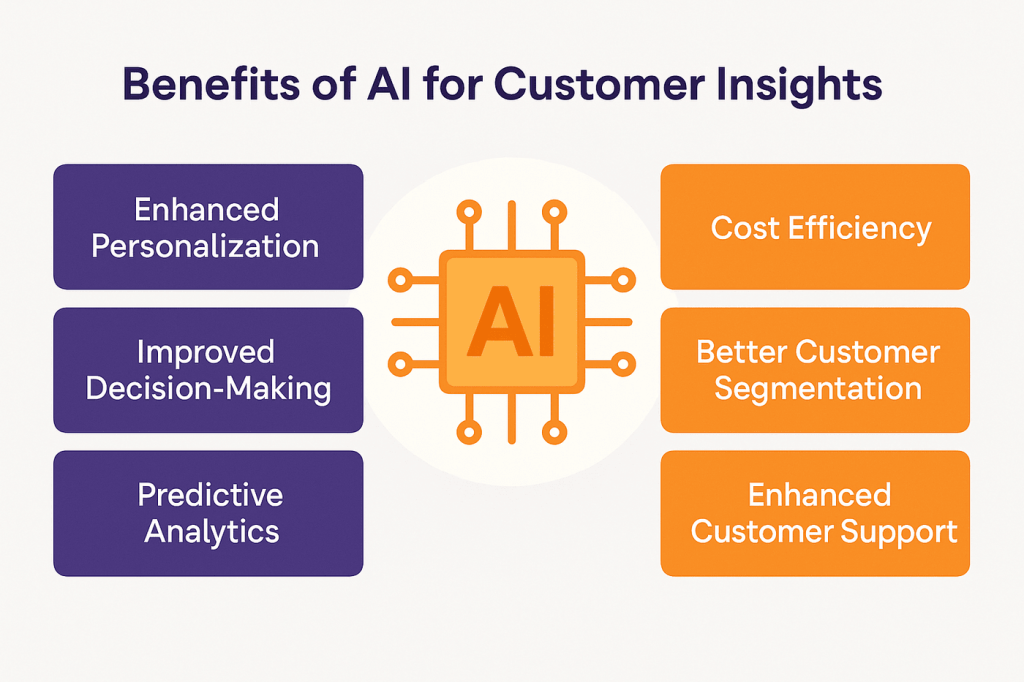
1. Enhanced Personalization Drives Revenue Growth
AI customer analytics enables mass personalization by identifying individual customer preferences and behavioral patterns. This capability supports targeted marketing campaigns, personalized product recommendations, and customized service experiences that increase customer lifetime value.
Companies using AI-driven personalization report average revenue increases of 15-25% compared to generic approaches, according to McKinsey & Company.
2. Data-Driven Decision Making Reduces Risk
AI customer analytics provides objective data insights that reduce reliance on intuition and assumptions in customer-related decisions.
Leveraging robust data analytics solutions helps ensure that decisions are grounded in evidence, minimizing the risk of strategic mistakes and improving the effectiveness of resource allocation.
Decision-makers gain greater confidence in customer strategy changes when supported by comprehensive data analysis rather than limited sample sizes or anecdotal evidence.
3. Predictive Capabilities Enable Proactive Management
The ability to anticipate customer needs and problems before they occur transforms customer management from reactive to proactive. This shift improves customer satisfaction while reducing the cost of issue resolution.
Proactive customer management also creates competitive advantages by addressing customer concerns before competitors even recognize they exist.
4. Operational Efficiency Reduces Costs
Automation of routine analysis tasks and intelligent routing of customer inquiries reduces operational costs while improving service quality. AI systems handle volume fluctuations more efficiently than manual processes, providing consistent service levels during peak periods.
According to research, cost reduction typically ranges from 20-35% for customer service operations that successfully implement AI customer analytics.
5. Advanced Segmentation Improves Targeting
AI systems identify customer segments based on behavioral patterns and preferences rather than just demographic characteristics. This sophisticated segmentation enables more precise targeting for marketing campaigns and service delivery strategies.
With the rise of generative AI for data analytics, organizations can now generate deeper insights and create dynamic segment profiles that evolve with real-time customer behavior.
Behavioral segmentation often reveals valuable customer groups that traditional demographic analysis misses, creating new revenue opportunities.
6. Intelligent Support Systems Enhance Service Quality
AI-powered support systems provide agents with real-time insights and recommendations that improve first-call resolution rates and customer satisfaction scores. These systems also ensure consistent service quality across different agents and interaction channels.
How to Implement AI in Customer Analytics: Best Practices for Success
Implementation success depends on strategic planning and methodical execution rather than technology deployment alone.
Set Clear Objectives
Successful AI customer analytics projects start with specific, measurable objectives tied to business outcomes. Rather than implementing AI for its own sake, organizations should identify particular customer challenges or opportunities that AI can address.
Clear objectives help teams make better technology choices and measure implementation success objectively.
Invest in High-Quality Data
AI systems are only as effective as the data they analyze, making data quality investment essential for successful outcomes. This includes data cleaning, standardization, and customer data integration across different systems and sources.
Organizations should audit their current data quality and address gaps before implementing AI systems rather than expecting the technology to solve data problems automatically.
Select the Right AI Tools
Different AI customer analytics platforms excel in various areas. Some focus on real-time analysis while others specialize in predictive modeling.
Understanding the benefits of real-time analytics, such as immediate insights, faster decision-making, and improved customer responsiveness, can help guide the right tool selection.
Enterprises should evaluate platforms based on their ability to integrate with existing systems and scale with business growth rather than just feature lists.
Integrate AI with Existing Systems
AI customer analytics platforms must integrate seamlessly with CRM systems, support platforms, and other customer-facing technologies to deliver value. Isolated systems create data silos that limit analytical insights and user adoption.
Partnering with a team that specializes in data integration consulting can help ensure compatibility, reduce friction during implementation, and streamline connections across platforms.
Integration planning should happen early in the implementation process to avoid technical challenges that delay deployment.
Train & Educate Your Team
Even sophisticated AI systems require human expertise for optimal results. Teams need training on how to interpret AI insights, act on recommendations, and continuously improve system performance.
Training should focus on practical application rather than just technical features, helping teams understand how to use AI insights for better customer outcomes.
Continuously Monitor & Improve
AI customer analytics systems require ongoing monitoring and optimization to maintain effectiveness. Customer behavior changes over time, requiring model updates and performance adjustments.
As part of a broader data strategy assessment, organizations should establish regular review processes to evaluate system performance and uncover opportunities for continuous improvement.
What Challenges and Ethical Considerations Should Enterprises Anticipate?
Understanding potential challenges helps organizations prepare appropriate responses and minimize implementation risks, including:
Data Privacy and Security Concerns
AI customer analytics systems process sensitive customer information, creating significant privacy and security responsibilities. Organizations must ensure compliance with regulations like GDPR and CCPA while maintaining system effectiveness.
Privacy by design principles should guide system architecture decisions, incorporating data protection measures from the beginning rather than adding them later. This includes secure data integration techniques that ensure customer information flows safely across systems without exposing vulnerabilities or violating compliance standards.
Algorithm Bias Can Create Unfair Outcomes
AI systems can perpetuate or amplify biases present in training data, leading to unfair treatment of certain customer groups. Organizations must actively monitor for bias and implement corrective measures when issues are identified.
Regular bias audits and diverse training data help minimize these risks, but they require ongoing attention rather than one-time fixes.
Transparency Builds Trust with Stakeholders
AI decision-making processes can seem opaque to customers and employees, creating trust issues that undermine system effectiveness. Organizations should prioritize explainable AI approaches that provide clear reasoning for recommendations and decisions.
Transparency also supports regulatory compliance and helps teams understand how to improve system performance over time.
Automation Balance Maintains Human Connection
Over-reliance on automation can create impersonal customer experiences that damage relationships and brand perception. Successful implementations balance AI efficiency with human touch points that preserve customer connection.
A well-defined data analytics framework can guide organizations in determining which interactions should be automated and which ones require a human touch, ensuring optimal outcomes and a more empathetic customer experience.
Turn your data into real-time, predictive intelligence.
FAQs
What types of customer data does AI analyze?
AI analyzes structured data like transactions and demographics, and unstructured data such as chats, emails, and social media. It also evaluates behavioral patterns to predict future actions.
What are the key benefits of using AI for customer analytics?
AI enables real-time insights, automates large-scale analysis, boosts personalization, and improves efficiency while reducing operational costs.
What are common use cases for AI in customer analytics?
Use cases include churn prediction, sentiment analysis, campaign targeting, and customer lifetime value modeling for proactive decision-making.
Is AI customer analytics only for large enterprises?
No. Cloud-based AI tools make it accessible to mid-sized companies with quicker deployment and faster ROI.
Conclusion
AI-driven customer analytics is reshaping how businesses understand, engage, and retain customers. It turns raw data into actionable intelligence, helping brands deliver personalized experiences while optimizing costs. As this technology becomes more accessible, companies of all sizes can leverage its potential. Ready to future-proof your customer strategy? Start exploring how data can drive smarter decisions today.
Folio3 Data Services offers customized AI solutions to uncover customer insights, streamline processes, and identify growth opportunities. Whether you’re just starting or scaling your data journey, Folio3 helps you harness the full power of customer analytics from day one.
